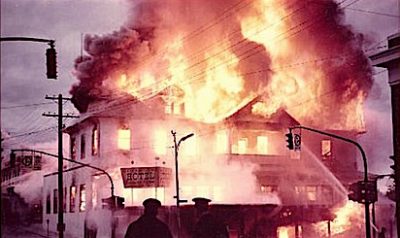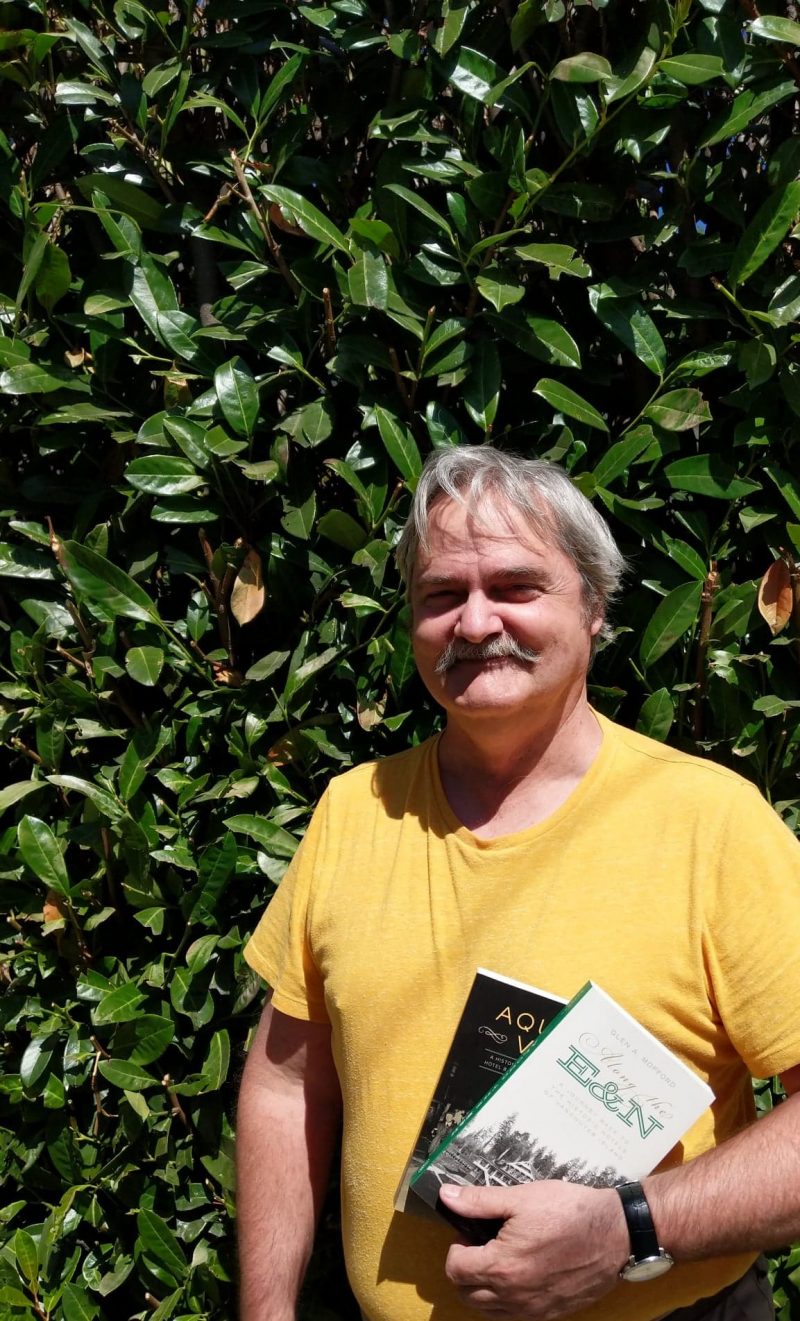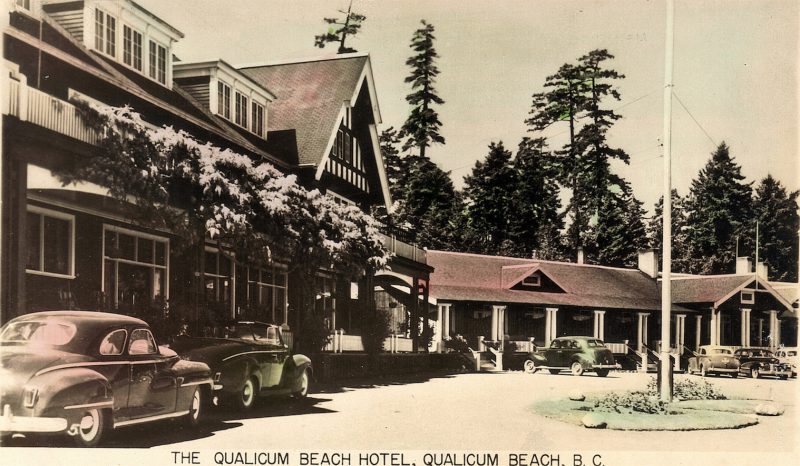#605 Island hotels & beer parlours
Along the E&N: A Journey Back to the Historic Hotels of Vancouver Island
by Glen Mofford
Victoria: TouchWood Press, 2019
$22.00 / 9781771512879
Reviewed by Ian J.M. Kennedy
*
 For 125 years, beginning in 1886, the Esquimalt and Nanaimo Railway served as Vancouver Island’s main railway line running from Victoria to Courtenay, with branch lines to Lake Cowichan and Port Alberni. In his book Along the E&N Glen Mofford takes readers on a captivating journey along this historic railway, describing the passing scenery as seen from the train’s windows, highlighting the histories of communities it passes through, and stopping along the way to visit thirty-two of the hotels that once stood close to the E&N tracks. The line actually stopped in Courtenay but Mofford takes licence and runs readers farther north to Campbell River because it had been the intended northern terminus of the railway, and the route had been surveyed all the way there.
For 125 years, beginning in 1886, the Esquimalt and Nanaimo Railway served as Vancouver Island’s main railway line running from Victoria to Courtenay, with branch lines to Lake Cowichan and Port Alberni. In his book Along the E&N Glen Mofford takes readers on a captivating journey along this historic railway, describing the passing scenery as seen from the train’s windows, highlighting the histories of communities it passes through, and stopping along the way to visit thirty-two of the hotels that once stood close to the E&N tracks. The line actually stopped in Courtenay but Mofford takes licence and runs readers farther north to Campbell River because it had been the intended northern terminus of the railway, and the route had been surveyed all the way there.
When planning the British Columbia portion of the Canadian Pacific Railway across Canada, Prime Minister John A Macdonald and CPR President Donald Smith intended the terminus of their “National Dream” to be Victoria, the capital of British Columbia, not Vancouver (known as Granville until 1886). Rather than travel down the Fraser Canyon as it eventually did, they hoped to run the main CPR line through the Cariboo, down the side of Mount Waddington, along the edge of Bute Inlet, over to Vancouver Island on a series of bridges across the Discovery Islands and Johnstone Strait, and finally down the east side of Vancouver Island to Victoria. That plan came to nothing. Instead, in 1883, coal baron Robert Dunsmuir negotiated a deal that saw him receive $750,000 and twenty percent of Vancouver Island to build the Esquimalt and Nanaimo (E&N) Railway.

PM John A Macdonald hammered in the last spike of the E&N at Cliffside, near Shawnigan Lake, in 1886, thus completing the first phase of the new railway. Even at that early date, hotels had begun to spring up along the line to serve those travelling on the newly-laid track. Some of these hotels proved quite palatial such as the forty-room Strathcona Hotel at Shawnigan Lake, pictured on the cover of Mofford’s book. Here patrons could enjoy rooms featuring hot and cold running water and private baths, three hard-surfaced tennis courts, boat rentals for rowing or fishing, a putting green, and croquet. All this for $3.50 a day or $21 per week.


Not all the hotels were quite so ostentatious, far from it, and none rivalled the stately, stone-built hotels along the CPR line such as those at Banff Springs, Lake Louise, and Vancouver. Those structures have long outlasted the modest wooden hotels built along the E&N, a great many of which succumbed to fire, with some going up in flames twice after being re-built. Of the thirty-two hotels in the book, twenty-seven experienced fires and only nine exist today.
Mofford offers wonderful stories about the proprietors and patrons of the hotels he describes. He recounts the fascinating tale of murder and suicide at the Mount Sicker Hotel perpetrated by a jealous suitor of the widowed owner; the visit of industrial titans John D. Rockefeller and Andrew Carnegie to the Horseshoe Bay Hotel in Chemainus in 1910; he even tells of Mike the bartending dog in Bowser. He also explains how, when Robert Dunsmuir’s son, James, founded Ladysmith in 1900, he had the thirty-room Abbotsford Hotel in Wellington deconstructed and transported on E&N flatcars to Ladysmith, where it was reassembled. It served there until 1959 when it was demolished.
In its heyday the E&N served as an important economic stimulus to the economy of Vancouver Island, carrying coal, lumber, and freight, just as B.C.’s first millionaire Robert Dunsmuir intended. The railway also ran excursions to the various hotels along the line, particularly those near Victoria. For instance, holidaymakers could purchase a day return ticket for $1.25 ($.25 for children) travel the seventy-two miles to Shawnigan Lake, enjoy a swim, lay out a picnic or have lunch in one of three hotels, take a hike, row a boat, fish, or just relax by the side of the lake before returning home at day’s end.

Mofford’s fine social history reminds readers of a bygone, simpler and less frenetic time, well illustrated by the many photographs of hotels, trains, and social life at the height of the E&N’s glory days. Three images in particular deserve mention. One is of Bill Derby, Canada’s first recipient of the Old Age pension, sitting in the Arlington Hotel in Port Alberni having a beer in 1927, happily spending the first pension cheque of $20 he had received from the government.

Another is an early 1940s picture of the Bowser Hotel featuring Mike, the beer-toting, sheepdog-terrier cross who even featured in Life magazine. The dog seems entirely at ease in the beer parlour, toting beer bottles around in his mouth and the glimpse of the beer parlour he “worked” in will instantly take older readers back to those depressingly soulless establishments of not so long ago. Many of us cringe at the memories. Remember those round, Formica-topped, steel-bordered tables with overflowing ashtrays and salt shakers, and the wire mesh screens around the bars? This photo will make readers realize just how far drinking establishments have progressed in B.C.
The book’s final illustration shows an aged patron sitting outside, on an old chair from the pub, watching the demolition of the Tzouhalem Hotel in Duncan — a poignant image to end the book.

The advent of better roads and automobiles in the 1920s and 1930s eventually saw the E&N lose its importance, leading to its slow demise. It closed in 2011. Railway enthusiasts still lobby for its return, though resurrection is doubtful.
Mofford is to be commended, not only for his meticulous research but also for his attention to detail and his selection of fine illustrations. His inclusion of useful maps, an historic timeline, bibliography, and endnotes as well as his helpful selected biography establishes him as a social historian of British Columbia worth noting. Railway enthusiasts and local history buffs will surely enjoy this book.

*

Born in County Donegal, Ireland, Ian J.M. Kennedy came to Canada in 1954 where he attended Burnaby North High School and earned a B.A. from UBC. Later he did post-graduate work at Queen’s University, Belfast, and on his return to Canada taught geography and history at Steveston Secondary School for thirty years. Following his retirement in 1999, he moved to Comox and became a rugby journalist, travelling the world and writing about a game he never played very well. Widely published in many magazines, his journalism also includes numerous articles about history, travel, motorcycling, cottage living, and pubs. His books include Guide to the Neighbourhood Pubs of the Lower Mainland (Gordon Soules, 1982), The Pick of the Pubs of B.C. (Heritage House, 1986), Sunny Sandy Savary: A History of Savary Island 1792-1992 (Kennell, 1992), The Life and Times of Joe McPhee, Courtenay’s Founding Father (Kennell, 2010), and Tofino and Clayoquot Sound: A History (Harbour, 2014), co-authored with Margaret Horsfield.
*
The Ormsby Review. More Books. More Reviews. More Often.
Publisher and Editor: Richard Mackie
The Ormsby Review is a journal service for serious coverage of B.C. books and authors, hosted by Simon Fraser University. The Advisory Board consists of Jean Barman, Robin Fisher, Cole Harris, Wade Davis, Hugh Johnston, Patricia Roy, David Stouck, and Graeme Wynn. Scholarly Patron: SFU Graduate Liberal Studies. Honorary Patron: Yosef Wosk. Provincial Government Patron since September 2018: Creative BC
“Only connect.” – E.M. Forster

2 comments on “#605 Island hotels & beer parlours”
Unfortunately, you’ve no pics of the inside of the Oxy, when the walls of the pub were lined with stuffed animals.Pics of the lobby and the upstairs and a couple of the rooms would’ve been good to see, too.
Thank-you very much Mr. Ian Kennedy for capturing the essence of my latest book, Along the E&N: A Journey Back to the Historic Hotels of Vancouver Island. I am pleased and amazed at the reaction of BC history buffs and readers who have lived or are currently living on Vancouver Island to the release of my book. The E&N and most of the historic hotels featured in my book are gone but interest in their history is as strong as ever. I appreciate your review and I also thank those who have read and enjoy Along the E&N. I hope it brings back some happy memories.
Comments are closed.